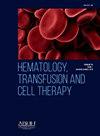18f-fdg pet / ct与18f-psma pet / ct在放射性碘难治性分化型甲状腺癌中的直接比较
IF 1.8
Q3 HEMATOLOGY
引用次数: 0
摘要
分化型甲状腺癌(DTC)是最常见的内分泌恶性肿瘤,治疗得当,预后良好。然而,大约5-15%的病例对放射性碘治疗(rRIT)产生难治性,限制了诊断和治疗选择,并显著影响患者的生存。最近的研究表明,前列腺特异性膜抗原(PSMA)在晚期DTC的正电子发射断层扫描/计算机断层扫描(PET/CT)中摄取,表明其作为诊断成像靶点的潜力,并可能为治疗方法开辟新的途径。目的比较18F-PSMA和18f -氟脱氧葡萄糖(18F-FDG) PET/CT扫描对rRIT DTC的影响。材料和方法本横断面研究纳入21例rRIT DTC伴局部或远处转移的患者。所有患者均接受了18F-FDG PET/CT和18F-PSMA PET/CT扫描。使用最大标准化摄取值(SUVmax)评估摄取强度,并将病变部位分类为甲状腺床、颈部、胸部和腹部淋巴结、肺、肝脏和骨骼。计算了两种放射性示踪剂的中位SUVmax(范围)。结果两种示踪剂均能检出病变。18F-FDG PET/CT和18F-PSMA PET/CT分别在每个区域识别出活动性疾病的患者数量分别为:甲状腺床(6对5)、颈部淋巴结(15对15)、胸部淋巴结(11对11)、腹部淋巴结(3对0)、肺部(16对15)、骨骼(4对6)和肝脏(1对1)。在5例患者中,18F-FDG识别出的病变区域多于18F-PSMA,而在3例患者中,观察到相反的情况。18F-FDG的中位SUVmax为24.2 (5.6-80.9),18F-PSMA的中位SUVmax为17.3(4.1-73.3)。12例(57.14%)患者18F-PSMA的SUVmax高于18F-FDG。结论两种示踪剂在所有rRIT DTC患者中至少部分病变中显示摄取。不同病变的摄取强度不同,一些病变表现出更高的18F-FDG摄取,而另一些病变表现出更高的18F-PSMA摄取,这表明这些示踪剂在该疾病中具有潜在的互补作用。在超过一半的患者中,18F-PSMA显示出比18F-FDG更高的SUVmax,这表明,在选定的病例中,psma标记的治疗方法可能是一种可行的选择。本文章由计算机程序翻译,如有差异,请以英文原文为准。
DIRECT COMPARISON BETWEEN 18F-FDG PET/CT AND 18F-PSMA PET/CT IN RADIOIODINE-REFRACTORY DIFFERENTIATED THYROID CARCINOMA PATIENTS
Introduction/Justification
Differentiated thyroid carcinoma (DTC) is the most common endocrine malignancy and generally has a good prognosis when properly treated. However, approximately 5-15% of cases become refractory to radioiodine therapy (rRIT), limiting diagnostic and therapeutic options and significantly impacting patient survival. Recent studies have demonstrated prostate-specific membrane antigen (PSMA) uptake in positron emission tomography/computed tomography (PET/CT) scans of advanced DTC, suggesting its potential as a diagnostic imaging target and possibly opening new avenues for theranostic approaches.
Objectives
To compare 18F-PSMA and 18F-fluorodeoxyglucose (18F-FDG) PET/CT scans of patients with rRIT DTC.
Materials and Methods
This cross-sectional study included 21 patients with rRIT DTC and locoregional or distant metastases. All patients underwent both 18F-FDG PET/CT and 18F-PSMA PET/CT scans. Uptake intensity was assessed using the maximum standardized uptake value (SUVmax), and lesion location was categorized as thyroid bed, cervical, thoracic, and abdominal lymph nodes, lungs, liver, and bones. The median SUVmax (range) was calculated for both radiotracers.
Results
Both radiotracers detected lesions in all patients. The number of patients with active disease identified by 18F-FDG PET/CT and 18F-PSMA PET/CT, respectively, in each region was: thyroid bed (6 vs. 5), cervical lymph nodes (15 vs. 15), thoracic lymph nodes (11 vs. 11), abdominal lymph nodes (3 vs. 0), lungs (16 vs. 15), bones (4 vs. 6), and liver (1 vs. 1). In five patients, 18F-FDG identified more affected regions than 18F-PSMA, while in three patients, the opposite was observed. The median SUVmax was 24.2 (5.6–80.9) for 18F-FDG and 17.3 (4.1–73.3) for 18F-PSMA. In 12 patients (57.14%), the SUVmax of 18F-PSMA was higher than that of 18F-FDG.
Conclusion
Both radiotracers demonstrated uptake in at least some lesions in all rRIT DTC patients. Uptake intensity varied among lesions, with some showing higher 18F-FDG uptake and others higher 18F-PSMA uptake, suggesting a potential complementary role for these tracers in this disease. 18F-PSMA demonstrated a higher SUVmax than 18F-FDG in more than half of the patients, indicating that, in selected cases, PSMA-labeled theranostic approaches may be a viable option.
求助全文
通过发布文献求助,成功后即可免费获取论文全文。
去求助
来源期刊

Hematology, Transfusion and Cell Therapy
Multiple-
CiteScore
2.40
自引率
4.80%
发文量
1419
审稿时长
30 weeks
 求助内容:
求助内容: 应助结果提醒方式:
应助结果提醒方式:


